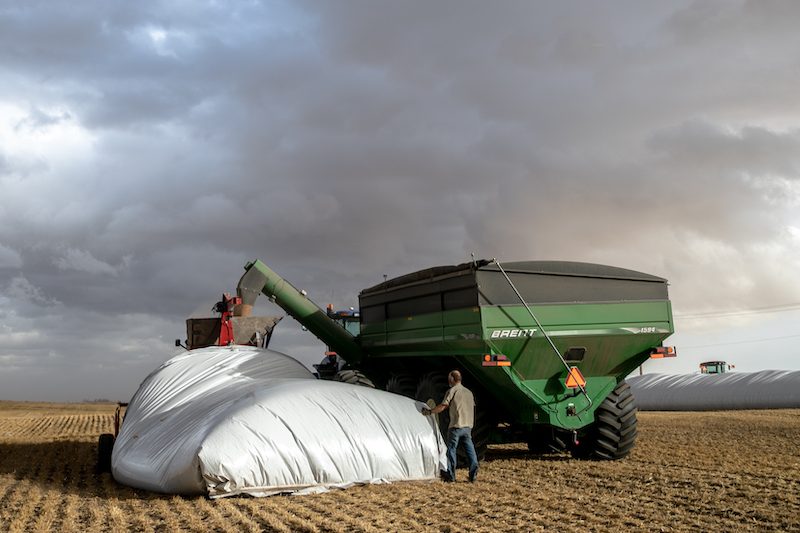AB Direct - Steers
Rail: 492.00-498.50 FOB feedlot (last week)
AB Direct - Heifers
Rail: 492.00-498.50 FOB feedlot (last week)
US Trade- Steers
Rail: 380.00 NE, IA (last week)
US Trade - Heifers
Rail: 380.00 NE, IA (last week)
Canadian Dollar
0.04

Managing ag plastics long-term — can product suppliers play a bigger role?
In Canada and around the world, certain industry sectors take responsibility for managing their products and packaging when consumers/users are finished with them (typically called at ‘end of life’) so the resources can be recovered and reinvested in the economy.
In these cases, a variety of market forces encourage these companies, called ‘producers’, that supply or import products and packaging into the market to take on this important responsibility. An example of a voluntary, industry-wide initiative that keeps agricultural plastic out of landfills and off farmland is Cleanfarms’ empty container recycling program. Now a national program, it got its start in Alberta more than 30 years ago.
Some provinces have adopted regulatory mechanisms to ensure that products like electronics, paper and packaging (blue cart and bag programs), tires, among others, are properly managed.
Generally referred to as ‘extended producer responsibility (EPR)’, this policy approach not only requires producers to take responsibility for the end-of-life management for their products and packaging but it also encourages them to design products that are more durable and recyclable so materials and components continue to be used in the economy for as long as possible. An example in agriculture is the reusable 1000L tote that, in some cases, is used to replace individual 23L single use pesticide and fertilizer containers.
EPR regulations place legal obligations on industry producers to develop, operate and fund these programs, but they do not place any obligations on the product user; for example, in reference to agricultural plastics, the farmer.
Manitoba has established an EPR policy to require that industry producers take responsibility for collecting and recycling grain bags, baler twine and pesticide and fertilizer containers. Prince Edward Island just passed a provincial regulation that impacts ag plastics. Saskatchewan was the first province to establish EPR for grain bags.
Now in its fourth year of operation, recycling has increased from 1,257 tonnes in year one to 2,536 tonnes in 2020.

How EPR Enables Recycling
Many waste management programs are currently financed through municipal taxes so property taxpayers pay the cost of waste collection and disposal. EPR ensures that the legal and financial responsibility for managing materials at end of life is shifted away from municipalities and broader taxpayers and onto the producers that make or import the products.
When an EPR policy has been established, often industry producers will create a stewardship organization that is charged with the responsibility of developing and operating the collection programs. Funds are raised to operate the programs through stewardship fees that the producers pay based on the types and amount of product or packaging each company puts on the market and that is recovered for recycling. Provincial EPR regulations typically set a target percentage that is to be recovered for recycling each year. Cleanfarms is an example of an industry stewardship organization that develops and operates national and regional programs on behalf of its member companies, many of which are in crop input industries.
Depending on the material, municipalities often act as collection sites for these stewardship programs and are compensated for the important role they play in ensuring that users in their communities can access these services.
For used ag plastics, farmers are usually asked to prepare them by shaking out excessive dirt and snow and rolling or bagging materials to transport them to designated collection locations.
The parties obligated through EPR are then responsible for arranging transportation from collection sites to specific recycling facilities. In the case of grain bags, two recycling facilities are in Alberta and one is in the USA where the plastic is processed into pellets which are then used to make products like plastic bags, dimensional plastic lumber, and agricultural fence posts.
Depending on market conditions, revenue can be generated from the sale of used ag plastics to recycling facilities. However, the revenues generally do not cover all the costs involved with transporting materials to end markets, compensating collection sites and associated administration. To cover this cost differential, producers have the choice to absorb recycling costs into the price of the product, or establish an environmental handling fee (EHF), which is a separate fee the user sees at the point of purchase. As an example, in Saskatchewan, grain bag recycling is funded through a non-returnable EHF that ranges from $37 for a 9 x 250 foot bag to $66 for a 10 x 400 foot bag. Costs vary depending on the weight of the bag and it works out to about $25 cents per kilogram.
Alberta is currently developing policy changes to enable Extended Producer Responsibility (EPR) in the province. More details are available here.
